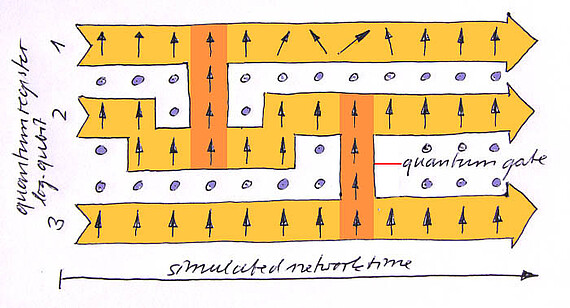Zeige Ergebnisse 1 -
20
von 89
2024
Adhikary A, Yang W, Raussendorf R. Counterintuitive Yet Efficient Regimes for Measurement-Based Quantum Computation on Symmetry-Protected Spin Chains. Physical Review Letters. 2024 Okt 16;133(16):160601. doi: 10.1103/PhysRevLett.133.160601, 10.48550/arXiv.2307.08903
Hantzko L, Binkowski L, Gupta S. Tensorized Pauli decomposition algorithm. Physica scripta. 2024 Jul 26;99(8):085128. Epub 2024 Jul 17. doi: 10.1088/1402-4896/ad6499
Qin Z, Azses D, Sela E, Raussendorf R, Scarola VW. Redundant string symmetry-based error correction: Demonstrations on quantum devices. Physical Review A. 2024 Jul 31;110(1):012465. doi: 10.48550/arXiv.2310.12854, 10.1103/PhysRevA.110.012465
Zurel M, Okay C, Raussendorf R. Simulating Quantum Computation: How Many "Bits" for "It"? PRX Quantum. 2024 Sep 3;5(3):030343. doi: 10.48550/arXiv.2305.17287, 10.1103/PRXQuantum.5.030343
2023
Horodecki K, Zhou J, Stankiewicz M, Salazar R, Horodecki P, Raussendorf R et al. The rank of contextuality. New journal of physics. 2023 Jul 10;25(7):073003. doi: 10.1088/1367-2630/acdf78
Qin Z, Scarola VW, Raußendorf R, Sela E, Azses D. Symmetry Protection of Measurement-based Teleportation in Ising Graphs. 2023. Abstract von APS March Meeting 2023, Las Vegas, Nevada, USA / Vereinigte Staaten.
Raussendorf R, Herringer P. Classification of measurement-based quantum wire in stabilizer PEPS. Quantum. 2023 Jun 12;7:1041. doi: 10.22331/q-2023-06-12-1041
Raussendorf R. Putting Paradoxes to Work: Contextuality in Measurement-Based Quantum Computation. in Palmigiano A, Sadrzadeh M, Hrsg., Samson Abramsky on Logic and Structure in Computer Science and Beyond. Springer Science and Business Media B.V. 2023. S. 595-622. (Outstanding Contributions to Logic). doi: 10.48550/arXiv.2208.06624, 10.1007/978-3-031-24117-8_16
Raussendorf R, Okay C, Zurel M, Feldmann P. The role of cohomology in quantum computation with magic states. Quantum. 2023 Apr 13;7. doi: 10.48550/arXiv.2110.11631, 10.22331/q-2023-04-13-979
Zurel M, Cohen LZ, Raußendorf R. Simulation of quantum computation with magic states via Jordan-Wigner transformations. 2023 Jul 29. Epub 2023 Jul 29. doi: 10.48550/arXiv.2307.16034
2022
Hantzko L, Kumar K, Picanço Costa G. Conserved charges for rational electromagnetic knots. The European physical journal:
Plus. 2022 Mär;137(3):407. Epub 2022 Mär 30. doi: 10.48550/arXiv.2106.05952, 10.1140/epjp/s13360-022-02563-4
Lee WR, Qin Z, Raussendorf R, Sela E, Scarola VW. Measurement-based time evolution for quantum simulation of fermionic systems. Physical Review Research. 2022 Jul 25;4(3):L032013. doi: 10.1103/PhysRevResearch.4.L032013
Raußendorf R, Yang W, Adhikary A. Measurement-based quantum computation in finite one-dimensional systems: string order implies computational power. 2022 Okt 11. Epub 2022 Okt 11. doi: 10.48550/arXiv.2210.05089
Stephen DT, Ho WW, Wei TC, Raußendorf R, Verresen R. Universal measurement-based quantum computation in a one-dimensional architecture enabled by dual-unitary circuits. 2022 Sep 13. Epub 2022 Sep 13. doi: 10.48550/arXiv.2209.06191
Watkins GW, Nguyen HM, Lau HK, Paler A, Pearce S, Raußendorf R et al.. Lattice Surgery Quantum Error Correction Compiler. 2022. Abstract von APS March Meeting 2022, Chicago, USA / Vereinigte Staaten.
Wei TC, Raußendorf R, Affleck I. Some Aspects of Affleck–Kennedy–Lieb–Tasaki Models: Tensor Network, Physical Properties, Spectral Gap, Deformation, and Quantum Computation. in Bayat A, Bose S, Johannesson H, Hrsg., Entanglement in Spin Chains: From Theory to Quantum Technology Applications. Springer, Cham. 2022. S. 9–125. (Quantum Science and Technology). doi: 10.48550/arXiv.2201.09307, 10.1007/978-3-031-03998-0_5
Wong G, Raußendorf R, Czech B. The Gauge Theory of Measurement-Based Quantum Computation. 2022 Jul 20. Epub 2022 Jul 20. doi: 10.48550/arXiv.2207.10098
Yang W, Nocera A, Herringer P, Raussendorf R, Affleck I. Symmetry analysis of bond-alternating Kitaev spin chains and ladders. Physical Review B. 2022 Mär 25;105(9):094432. doi: 10.48550/arXiv.2201.03132, 10.1103/PhysRevB.105.094432
2021
Okay C, Zurel M, Raussendorf R. On the extremal points of the Λ-polytopes and classical simulation of quantum computation with magic states. Quantum Information and Computation. 2021 Nov;21(13-14):1091–1110. doi: 10.48550/arXiv.2104.05822, 10.26421/QIC21.13-14-2, 10.26421/QIC22.7-8-4
Raußendorf R, Zurel M, Okay C. Method of simulating a quantum computation, system for simulating a quantum computation, method for issuing a computational key, system for issuing a computational key. WO2021195783A1. 2021 Okt 7.


